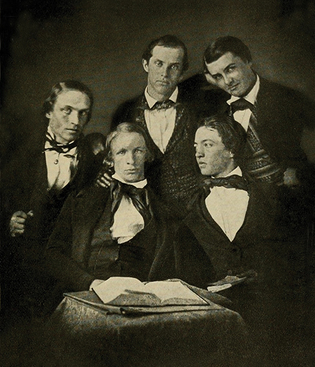
Frederick Law Olmsted made close friends during his time around Yale. Clockwise from left: Charles Trask ’46, Frederick Kingsbury ’46, John Hull Olmsted ’47, Fred Olmsted, and Charles Loring Brace ’46.
View full image
Frederick Law Olmsted (1822–1903) is remembered mainly as the designer of such public spaces as Central Park, Boston’s Emerald Necklace, and the US Capitol grounds. Some credit him with establishing the professions of landscape architect, sanitary engineer, and public health administrator. He’s also known as an influential anti-slavery reporter and author of The Cotton Kingdom. Less known are his ties to Yale. Was Olmsted a Yale alum? Sort of.
Anson Phelps Stokes, Class of 1896, thought Olmsted enough of a Yalie to include him in his massive biographical tome Memorials of Eminent Yale Men (1914). “Frederick Law Olmsted was not a graduate,” wrote Stokes, “but all of his university training was in the New Haven laboratories, in the early days when the Sillimans and their associates were laying the foundations which developed into the Sheffield Scientific School”—Yale’s first major science establishment.
Olmsted was the son of a wealthy Hartford businessman; his younger brother John graduated from Yale College in 1847. The Olmsted name was a prominent one at Yale: their kinsman Denison Olmsted, Class of 1813, was a professor of mathematics and natural philosophy in the college from 1825 until his death in 1859. Denison Olmsted was a nationally popular textbook author and the inventor of the radiator—used for the first time in his patented and profitable Olmsted stove. Stokes wrote that he was “an authority on shooting stars, and the teacher of a brilliant group of men who made Yale famous in astronomy all through the middle of the last century. He and Professor [Elias] Loomis were the first Americans to observe Halley’s comet, in 1835.”
Fred’s eclectic education had been a unique blend of private teachers, ministers, farmers, and businessmen. When he was 15, a case of sumac poisoning spread to his eyes and threatened him with blindness. He was advised to forgo college and spend as much time as possible outdoors until his eyes were better. In 1842 he began to visit his brother and other friends at Yale College.
By that time, Benjamin Silliman Sr., John Pitkin Norton, and Denison Olmsted had begun teaching courses privately in mechanics and agriculture, a program that would eventually lead to the establishment of the Sheffield School. Fred Olmsted participated in these courses, leading Stokes to list him as a nongraduate alumnus.
John Norton and Fred Olmsted led parallel lives in New Haven as private laboratory students of the Sillimans, with independent incomes that enabled them to travel abroad to study European scientific farming, forestry, and landscaping. In 1850, Fred traveled to Europe with his brother John and John’s Yale roommate, Charles Loring Brace ’46. Their six-month walking tour also included the art of park and garden planning. In Liverpool, Fred visited a park open to all that so impressed him that he considered it “the root of all my good work.” In 1852 Brace, an outspoken abolitionist, learned that the New York Times wanted to hire a writer to travel through the South to report on slavery. Fred Olmsted took the job, writing dispatches for the Times that were collected in book form in The Cotton Kingdom.
The death of his friend Norton at the age of 30 in 1852 moved Olmsted to focus on the creation of parks with environmental benefits for the public on city, state, and national levels. He applied science to improve the environment in his parkland projects, but he considered himself primarily an artist. Stokes commented that “the transition from Inventors to Artists is not so incongruous as it may appear—for this same faculty of the imagination is at the basis of both. In the case of Yale, the University’s greatest inventor— [Samuel F. B.] Morse—was also her best-known painter.”
After Olmsted’s death in 1903, the Times wrote: “Central Park . . . remains one of the most faultless works of art and one of the chief boasts of Manhattan. . . . It would be difficult to say that any American of his time has a better title to remembrance and gratitude as a public benefactor.”
 loading
loading